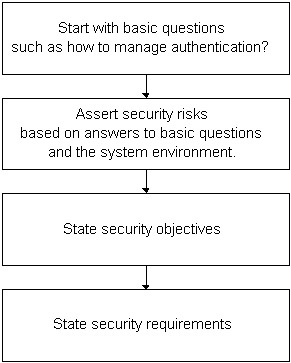Understanding Your Security Needs
There are many different reasons why you need security in your solution. The reasons typically include objective and subjective motivations to the selection or definition of the secure solution. Here are a few motivating questions:
Once you have addressed these questions (and all the others that are specific to your needs), you are ready to understand your security risks, specify your security objectives, and finally, state your security requirements. After your security requirements are clearly specified, you can start the selection of the technologies that best address your needs. This process is summarized in Figure 15-1.  Figure 15-1: Understanding your security needs Asserting your security risksOnce you understand how your system is required to address the security needs of the solution, you are ready to assert the possible security risks by analyzing your security requirements (derived from answering your basic questions) and the security environment in which the solution will exist. You need to define the risks to your solution and define the measures necessary to manage these risks to an acceptable level. To aid you in this definition you can analyze the possible threats and determine which ones apply to your solution. For instance, do you need to protect against loss of confidentiality? How about protecting against loss of integrity - damage through unauthorized access? Once you define the risks to your solution, you may want to understand the likelihood that the attack may be successful and the consequence the attack will have on your system. After this assertion, you are ready to clearly state the security objectives of your application. Stating your security objectivesYour organization probably has security policies and assumptions - if it does not, it should! You must be consistent with these policies when stating your solution's security objectives. The security objectives address the security concerns and requirements of the overall system. The security objectives are generated based on the following:
The objectives can be satisfied by the solution itself or by the environment in which the solution will reside. After you have clearly stated the security objectives, they are refined into security requirements. The system meets the security objectives if it correctly and effectively implements all the security requirements.
Java Security Solutions ISBN: 0764549286
EAN: 2147483647 Year: 2001
Pages: 222 Authors: Rich Helton, Johennie Helton
flylib.com © 2008-2017. If you may any questions please contact us: flylib@qtcs.net |